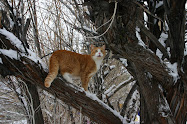
Fort Fred Steele is one of those places. It is 12 miles east of Rawlins. It was established in 1868 and abandoned in 1886 and sits on the bank of the North Platte River. The original fort was quite large.
This is one of two stone chimneys that once warmed the two large barracks. The last of the barracks were burned down in the 1970s during an act of arson.
I wanted to stay longer in that long lonely place, but thick storm clouds were crackling lighting and spitting rain.

Another building, possibly officers quarters with the remains of another building with a stone foundation.
 The view of the North Platte from the top of the small hill at the fort.
The view of the North Platte from the top of the small hill at the fort. Thousands of rocks were collected and stacked to create foundations, including a stone corral (but the weather prevented me from visiting the corral).
Thousands of rocks were collected and stacked to create foundations, including a stone corral (but the weather prevented me from visiting the corral). This is a far distant and isolated country. Beautiful.
This is a far distant and isolated country. Beautiful.
























